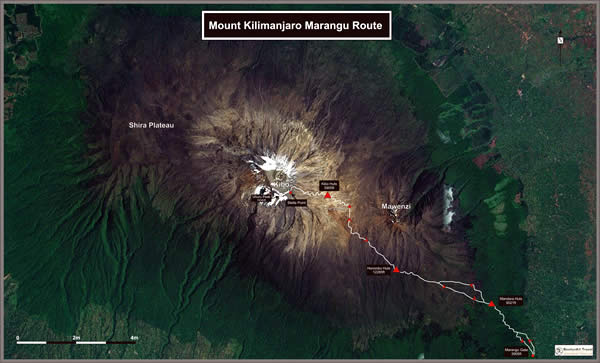Marangu Route
This is definitely the easiest and probably the most popular route for climbing Mount Kilimanjaro. It’s often called the Coca Cola Route because this is the only one where climbers can buy soft drinks and snacks at each stop on the way up. For what it’s worth, this route is also considered to be a bit of a joke by serious climbers, and in fact many of the more experienced operators don’t run trips up Marangu because it’s the least spectacular in scenery and it seems to attract the most people who aren’t really committed to doing it properly.
You can do Marangu in 5 or 6 days, and just as with the other routes, people tend to have a much greater rate of success if they choose the longer option. Having that extra day on the mountain to acclimatize can make a huge difference in your ability to make the summit on that final grueling day. The first few days are each around 5 hours of climbing, and each night you’ll reach a camp that has cabins full of bunk beds that can hold around 60 climbers in total. All the other routes require camping in tents, so these mountain huts make for a much different experience.
From Moshi to the Marangu Gate is 44 Km/28 miles. You begin by checking in at the park office and signing the register.
Here is the itinerary for the 5-day climb with notes about the 6-day version below:
Day 1:
Marangu Gate (1800 m/5,905 ft) to Mandara Hut (2750 m/9,021 ft)
Hike Time: 4 hrs to 5 hrs.
You begin through agricultural areas at the base of the mountain and continue into a rain forest for probably the best close-up scenery on the entire climb.
Day 2:
Mandara hut (2750 m/9,021 ft) to Horombo Hut (3780 m/12,400 ft)
Estimated Distance: 7km/4.43 Miles
Hike Time: 5 to 6 hrs.
You soon leave the rain forest and then go around the base of Maundi Crater before entering the moorland area. Horombo Hut is a collection of huts with double the capacity of the others since this is where descending climbers stay on their last night on the mountain as well.
Day 3:
Horombo Hut (3780 m/12,285 ft) to Kibo Hut (4,700 m/15,420 ft)
Estimated Distance: 12 Km/7.50 miles
Hike Time: 5 to 6 Hrs.
You leave the moorlands and spend most of the day in a desert-like area that begins to get steep. Conditions get extreme here as nighttime temperatures can fall below freezing and daytime temperatures can still be quite high. You’ll try to get to bed by 7 p.m. because you’ll be beginning your final ascent to the summit at around midnight.
Day 4:
Kibo Hut (4,700 m/15,420 ft) to Summit/Uhuru Peak (5,895 m/19,340 ft) back to Horombo Hut (3780 m/12,400 ft)
Estimated Distance: 10 km/6 miles
Hike Time: 14 to 16 hrs.
You’ll set off around midnight up a rocky trail to the Hans Meyer Cave and then to Gillman’s Point, after which you’ll spend about 2 hours climbing in snow up to Uhuru Peak AKA the summit! This is the most difficult day by far due to the combination of altitude and steepness of the climb, and this is where those who can’t make it usually turn back long before reaching Uhuru Peak. After spending time at the summit you’ll be heading down a few hours to Kibo Hut for a rest, and then down to Horombo for your last night on the mountain.
Day 5:
Horombo Hut (3780 m/12,285 ft) to Marangu Gate 1800M (5,850 ft)
Estimated Distance: (4 km/2.5 miles) ascend and (14 Km/8.75) descend
Hike Time5 to 7 Hrs.
You leave early retracing your steps back down to the Marangu Gate.
Why 6-day climbs are better
Day 3 on 6-day climbs begins and ends at Horombo Hut. This is where the 6-day climbs use an extra day to begin the acclimatization process. On a 6-day climb you’ll walk up past Zebra Rocks for about 3 hours before descending back to Horombo Hut for another night. This extra day to acclimatize is highly recommended if you are serious about making the summit.
After this Day 4 above becomes Day 5, and of course Day 5 above becomes Day 6. Statistics show that even though this is the easiest route it has the highest percentage of climbers who are unable to make the summit, and specifically it’s the 5-day climbers who really seem to struggle without that extra day to acclimatize.
